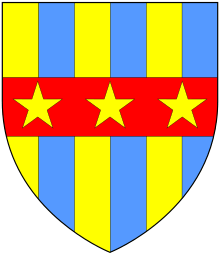John Clanvowe
Sir John Clanvowe (c. 1341–1391) was an English diplomat, soldier and poet. He was born to a Marcher family originally of Welsh extraction, and was himself probably of mixed Anglo-Welsh origin.[2] He held lands that lay in the present-day Radnorshire district of Powys and in Herefordshire.

Life
Clanvowe was a personal friend of Geoffrey Chaucer.[3] In 1386 they were both deponents in the Scrope v. Grosvenor case in the Court of Chivalry, in which Lord Scrope of Bolton and Sir Robert Grosvenor fought over the right to bear a particular coat of arms. Chaucer and Clanvowe testified in favour of Scrope.[4]
Clanvowe was one of the "Lollard knights", with supposedly heretical views, at the court of King Richard II.[5]
In 1390 he was campaigning with Louis II, Duke of Bourbon against Tunis.[6] He was buried with Sir William Neville (died October 10, 1391) in a joint tomb discovered in 1913 in Istanbul's Arap Mosque[7][8] in a way (helmets facing each other as if kissing, shields overlapping, impaled coats of arms) which would suggest a close relationship between the two men.[9]
Works
Clanvowe's best-known work was The Book of Cupid, God of Love or The Cuckoo and the Nightingale, a 14th-century debate poem influenced by Chaucer's Parliament of Fowls. In the poem, the nightingale praises love, but the cuckoo mocks it for causing more trouble than joy. It is written as a literary dream vision and serves as an example of medieval debate poetry. An organ concerto inspired by the poem was composed by Handel. Apparently the poem also influenced works by John Milton and William Wordsworth.
Clanvowe also wrote The Two Ways, a penitential treatise.[10]
Clanvowe is first mentioned in modern times in the History of English Literature by F. S. Ellis in 1896. The Cuckoo and the Nightingale had previously been attributed to Chaucer, but the Encyclopedia of Medieval Literature notes the absence of direct evidence linking Clanvowe with the work.[11]
References
- Maclean, Sir John & Heane, W.C., (Eds.), The Visitation of the County of Gloucester Taken in the Year 1623 by Henry Chitty and John Phillipot as Deputies to William Camden Clarenceux King of Arms, etc, London, 1885, p.130, pedigree of Poyntz, as quartered by Poyntz (mullets or "according to official record in the Heralds' College" (footnote 1)
- K. B. MacFarlane, Lancastrian Kings and Lollard Knights (Oxford, OUP: 1972), p. 231. McFarlane believed that his mother was a Talbot from the diocese of Hereford.
- Thomas Garbaty, Medieval English Literature (1984).
- Edith Rickert, Chaucer's World (1962), p. 147.
- David Aers, Culture and History, 1350–1600: Essays on English Communities, Identities, and Writing (1992), p. 9.
- http://www.litencyc.com/php/speople.php?rec=true&UID=891
- http://www.lrb.co.uk/v27/n11/davi02_.html
- Siegrid Düll, Anthony Luttrell and Maurice Hugh Keen: "Faithful unto death: the tomb slab of Sir William Neville and Sir John Clanvowe, Constantinople 1391". Antiquaries Journal, 71 (1993 for 1991), 174–190. ISSN 0003-5815.
- Bray, Alan. The Friend. Google Books.
- Lee Patterson, Chaucer and the Subject of History (1991), p. 38.
- Robert T. Lambdin, Laura C. Lambdin, Clanvowe, Sir John Encyclopedia of Medieval Literature (2000), pp. 104–105.
Further reading
- V. J. Scattergood (1975), The Works of Sir John Clanvowe
- David Wallace (editor), The Cambridge History of Medieval English Literature (2002), pp. 571–2.
